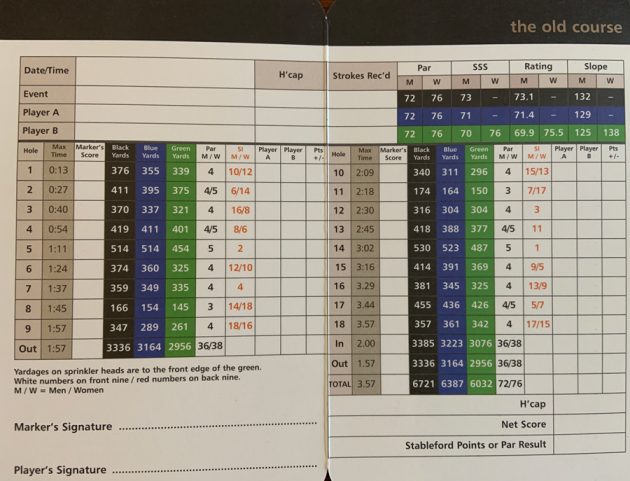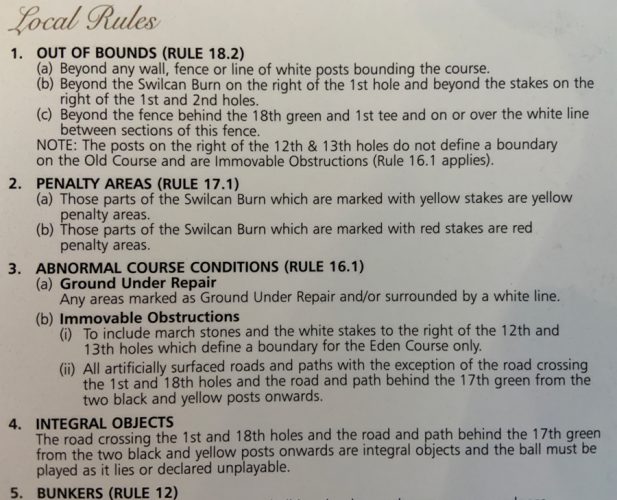How To Read A Golf Score Card
All the information you need to fully understand and make use of its contents


How to read a golf score card: All the information you need to fully understand and make use of its contents, and then fill it out correctly.
How To Read A Golf Score Card
On first glance, a golf score card contains a bamboozling assortment of numbers across a multi-coloured grid plus a selection of obscure looking instructions.
To the uninitiated eye, it’s a daunting prospect.
But having a good grasp of what those words and numbers indicate can help you more easily navigate a golf course, better understand its individual challenges and enjoy your game a little more overall.
Here we give you all the info you need on how to read a golf score card.
Decide on your tees
Get the Golf Monthly Newsletter
Subscribe to the Golf Monthly newsletter to stay up to date with all the latest tour news, equipment news, reviews, head-to-heads and buyer’s guides from our team of experienced experts.
When you open a standard golf scorecard, you’ll see a grid with an array of numbers and blank spaces.
Before you do anything else, you should look for the information that will guide the decision on what tees you should play off.
There may be a grid showing the total par and yardage from each set of tees, together with course and slope ratings.
Otherwise, the totals at the bottom of the main grid will show total yardage and par from each set of tees.
Use those figures to decide which tees suit you – If you’re a beginner, choose the shorter option, more experienced players may opt for a longer challenge.

Filling in your details?
At the top of the main section of the score card you’ll find some basic details you should fill in before playing.
There are spaces to enter the date and time of your round, the event and the names of the players competing.
There’s also a space to put in those players’ WHS Handicap Index and then the strokes they will receive on the day.
There should be a board by the first tee or pro shop that tells you what your Course Handicap will be from each set of tees, based on handicap index.
But if not, the card can help.
From each set of tees – the card should state the Course Rating and the Slope Index.
To calculate your Course Handicap yourself, take the Slope Rating and divide by 113, then multiply that by your Handicap Index.
Then, depending on the format you’re playing, you can work out strokes received for each player.
Check the local rules

Before teeing off, the score card will also have a page, perhaps on the rear side of the card, giving you the local rules.
Read these carefully, as they vary between courses.
The local rules will contain information on where the out of bounds lies – It’s not always just beyond white stakes, other demarcations may apply.
There will also be details on penalty areas, integral objects, immovable obstructions and abnormal course conditions.
You should give the local rules a thorough read before you begin.
However, you can also refer back to them during the round if an unusual situation occurs.
To the first
Now, on to the course and the information you have for each hole.
In the row for hole one, a series of columns give information and space for inputting scores and/or points.
The first column will generally be hole number, then there will be columns giving the total hole yardage from each tee.
There will also be a column showing the par of the hole.
Then there will be columns showing the Stroke Index of the hole for men and women.
That number shows whether or not you will be giving or receiving a shot on the hole.
Related: What is stroke index in golf?
After this comes column spaces to enter scores for up to four players – probably labelled A, B, C and D.
Write in scores corresponding to the names you have entered for A, B, C and D in the spaces above.
This repeats for all holes through the 18th.
After 9 and 18
After 9 holes have been finished, the score card provides space for halfway totals.
Tally up scores for the front side to see how each player is progressing and to simplify total calculations at the end of 18.
When 18 holes are done, there are spaces for back nine total, front nine total and full total.
Below these there will be space to re-enter each player’s handicap, then below again space to input a nett (after handicap) total and, if appropriate to the format, a points total.
Finish up and sign
Last thing to do is to sign your card.
There will be spaces for Marker’s and Player’s signatures.
Verify scores with the “Player” then sign the card you have marked as “Marker.” He or she should then sign as “Player” – Repeat in reverse with the person who has marked your card.
How to read a golf score card then?
Don’t be overawed by the details – each number and piece of written information could be useful to you.
Take on board the pars, yardage and slope ratings from different tees, have a good look at the local rules and then fill out the relevant spaces carefully.
At the end of a game, there’s something very satisfying about an accurately completed score card.

Fergus is Golf Monthly's resident expert on the history of the game and has written extensively on that subject. He has also worked with Golf Monthly to produce a podcast series. Called 18 Majors: The Golf History Show it offers new and in-depth perspectives on some of the most important moments in golf's long history. You can find all the details about it here.
He is a golf obsessive and 1-handicapper. Growing up in the North East of Scotland, golf runs through his veins and his passion for the sport was bolstered during his time at St Andrews university studying history. He went on to earn a post graduate diploma from the London School of Journalism. Fergus has worked for Golf Monthly since 2004 and has written two books on the game; "Great Golf Debates" together with Jezz Ellwood of Golf Monthly and the history section of "The Ultimate Golf Book" together with Neil Tappin , also of Golf Monthly.
Fergus once shanked a ball from just over Granny Clark's Wynd on the 18th of the Old Course that struck the St Andrews Golf Club and rebounded into the Valley of Sin, from where he saved par. Who says there's no golfing god?
-
 Meet The 8 Amateurs Playing In The Chevron Championship
Meet The 8 Amateurs Playing In The Chevron ChampionshipThe Chevron Championship includes eight amateurs – here are the details of the rising stars and how they reached the first women’s Major of the year
By Mike Hall
-
 How Much The Winning Caddie Earns At The RBC Heritage
How Much The Winning Caddie Earns At The RBC HeritageThe latest of the PGA Tour’s signature events offers a huge prize for the winner, and the caddie alongside the champion is due for a big payday too
By Mike Hall